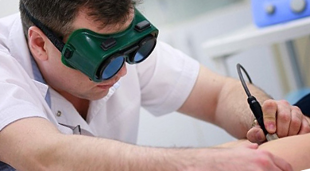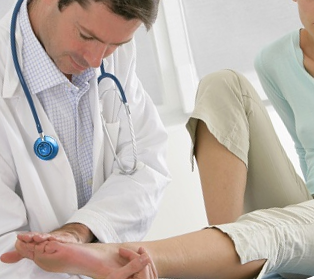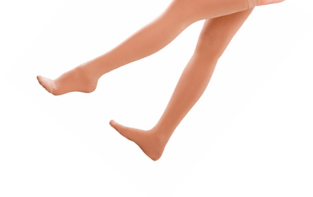Varicose legs disease is not only an aesthetic problem, but also a serious pathology, which is accompanied by dangerous health effects. The treatment of varicose veins with laser – one of the most modern, less traumatic and reliable ways to cope with the disease at an early stage. Allows you to achieve the aesthetic effect, you'll be minimum risk of complications and the recovery period.

Traditional medical therapy combined with therapeutic exercise and the wear correctional underwear also gives good results, but does not address the underlying cause of the disease. To solve radically the problem of patients vascular surgery is required. Classic surgery removal (phlebotomy) is hardly tolerated by patients, since it is very traumatic and is accompanied by a high risk of infectious complications. This method gradually disappears. In the shift coming minimally invasive procedures (sclerotherapy, laser therapy), which give an excellent result and allow you to quickly and painlessly get rid of varicose veins.
Laser treatment: the substance of the process
Varicose veins laser correction is considered to be the most reliable and effective method of treatment. On the basis of this method is the use of thermal effect for coagulation of blood vessels. Simply put, the driver, that is inserted into the affected vessel during the surgery, it emits the energy flow. This radiation is absorbed by the hemoglobin of the blood with a release of heat, which heats up the blood cells and walls of blood vessels. As a result, the blood has been squeezed out of the vessel, and the vein "signati". Blood circulation completely stops, and venous outflow from the tissue around it is already happening in other, healthy veins.
Wearing underwear compression after treatment of varicose veins with laser clipping effect, creating extra pressure in the container and does not allow to recover the blood flow in the injured vienna. Ship over time it gets closed connective tissue. Compliance with the measures for the prevention of varicose veins will not allow you to develop a defeat other veins, so that the illness will be cured forever.
The dignity of the method to slight traumatism, there is no loss of blood and extensive incisions. And since there is no portal of entry for infection, and the risk of damage of adjacent tissues and possible complications are reduced to a minimum.
The treatment of varicose veins with laser – less traumatic procedure, does not require special preparation and is performed under local anesthesia. The operation is performed only in specialized medical institution, the progress carried out ultrasonic testing in real-time. So the surgeon with the use of ULTRASOUND monitor promotion led to vienna. Before surgery, the patient will need to pass the required investigation, in which clarifies the position of the venous vessel and to choose the optimal method of laser coagulation.
When a surgery: indications

The basis for the conduct of surgery for the treatment of varicose veins with laser is used varicose subcutaneous veins (large and small). The laser is applied in the case of the mouth of these veins extend no more than 1 centimeter, the same vessels have smooth motion without sharp bends and branches of healthy or slightly extended. That is, the laser is only effective in the initial stage of varicose veins, to a small extent the seriousness of the process and only when applied to the subcutaneous veins. If the disease has begun, and the affected vessel expanded more than 1 cm, it is likely that in the future vienna, and again "evolve" and the treatment is ineffective.
Medical laser has a therapeutic effect in a very small area – this allows you to avoid negative effects to the surrounding tissue. Therefore, the use of laser therapy to large areas of damaged blood vessels, as well as in deep veins, it is ineffective. In these cases we have to apply other methods of surgical treatment, most suitable in a given situation (e. g., the classic phlebectomy).
Contraindications
In addition to the cases, when the laser is effective, there are cases when the application may harm the health of the patient. Contraindications for laser procedures enough of them can be divided into absolute and relative:
Absolute contraindications
When absolute contraindications conducting therapeutic manipulation categorically no. The list of these countries include:
- the tendency to thrombosis and thrombophlebitis;
- chronic disorders of blood circulation and lymph circulation in the legs?
- heavy defeat of the walls of veins.
In these conditions the laser can damage the walls of blood vessels or may cause massive thrombosis of the veins. Also in the contraindications referred to the inability to actively move and to wear a compressive knitted or crocheted. Without these activities in the postoperative period the laser treatment can lose its effectiveness, and in addition to cause inflammation of the vessel.
Relative contraindications

Relative contraindications – in which the procedure for the deferral time. Is inflammatory processes in the skin of the feet, especially in the parts of a future puncture, aggravation of chronic diseases. In this case you must first for the treatment of concomitant pathology, and only then to do the surgery. If you do not, then it is a very big risk of complications in the postoperative period, such as from the side, it works veins, and from the side of the disease was a contraindication for laser treatment.
Surgery should not be performed during pregnancy and breastfeeding, because in this period the immune system is weakened, and the load on the lower limbs more than usual. For the same reason it is difficult to conduct laser treatment of varicose veins in people with excess weight – it's worse tolerate anesthesia, when it is due to a large load on the legs possible complications in the postoperative period.
Description of the procedure for the treatment of varicose veins vein in foot laser
Despite the high cost of treatment of varicose veins in the legs of the laser, this procedure is gaining more and more popularity, thanks to its simplicity and effectiveness. To determine if the indication for surgery, pre-make duplex doppler ultrasonography. It helps to see the structure of the veins, the extent of damage and breach of the blood flow. If the state of the vessels of the patient allows for a laser treatment, you assign a function.
On the day of the procedure for special training of the patient is not necessary. If necessary, you can get a sedative drug. Before the operation becomes a two-way angiography, all manipulations are carried out under the control of ULTRASOUND. A small scale operation allows for the avoidance of general anesthesia and related complications – laser treatment is carried out under a local anesthetic, which has anaesthetic place of puncture.
The substance surgery for the treatment of varicose veins with laser is that through a small hole in the skin of the tibia in a damaged vessel is inserted into the guide connected to the laser device. Then, using laser radiation occurs coagulation damaged vessel, after which it is removed the driver seat hole is a local antiseptic and apply a sterile dressing. The procedure takes about 15 -30 minutes (for the treatment of a foot).
After the forced lying on the surgical table transition in the vertical position, it is recommended to slowly and gradually – first to sit, and only then to get up. This will avoid the vascular collapse in an abrupt change of the position of the body. No restriction exists. After some period of time after the surgery the patient can go home.
Postoperative period

Before surgery, the patient will need in advance to buy garment compression – stockings or tights. The degree of compression negotiation with your doctor in advance.
Since it's produced from the removal of varicose veins with laser, you will immediately need to wear compressive stocking on the leg. During the first two days should wear continuously, without the need to remove it. Then, if there will be complications, your doctor allow you to take therapeutic underwear for the night. The duration of wearing a medical jersey is gradually reduced as it works ship eventually gets closed connective tissue. Due to the necessity of wearing underwear compression mode trying to used in cold season of the year, so that the patient has not experienced any inconvenience with long-term wear socks. In addition, the health of patients with diseases of the blood vessels are much better in cool weather, from the heat.
The first week after treatment of varicose veins with laser should be avoided for important exercise for the legs, weight lifting, you can't attend the Turkish bath, the sauna or the swimming pool. In the following, we need to gradually increase the degree of physical activity. Recommended hiking, running and riding a bike, aerobics, swimming. The patient can do sports, walking long distances, led the vehicle. Reduction in striated muscles of the leg will perform the function of the secondary pump, and to contribute to the improvement of venous drainage from lower limbs. It is a natural mechanism, the use of which will help to prevent the recurrence of varicose veins after surgery.
To start, if not associated with great physical stress or long andreas in the legs, can be almost immediately, even the day of surgery. It is possible to work from home can also perform a few days after surgery. Walking can and should be already during the first minutes after the surgery, wearing a compression garment.
Possible complications
The treatment of varicose veins laser vein is particularly popular thanks to a recovery period, the absence of pain and minimal risk of complications. However, overall it can not be excluded. During the surgery, the pain can appear when a mistake of this anesthesia. After the procedure, the syndrome can manifest itself in the way it works of vienna. If it is painful is not subside within two days, you should definitely consult your doctor – this may be a sign of serious complications.
Errors in the conduct of manipulation can cause a burn of the skin and soft tissues, hematoma at the puncture location, suppuration and inflammatory processes. In rare cases it is possible that the thrombosis of the veins, including deep, that leads to a significant deterioration of the situation of the patient. You should immediately consult your doctor, if:
- during the first two days of pain in vienna and at the point of puncture do not subside or encouraged?
- the skin around the area of puncture showed signs of inflammation – redness and increased local temperature, the occurrence of septic foci that?
- when walking, you are experiencing muscle pain in legs, swelling, feeling of weight?
- appeared abnormal pigmentation in the skin of the feet;
- went up the temperature?
- any other unpleasant sensations in the legs – a violation of sensitivity, paresthesia.
To diagnose these complications, we recommend that the second day after the surgery to see a doctor – phlebologist and further regularly coming at a scheduled inspection.
Prevention measures

Experts advise to stick to simple preventive measures to prevent possible relapses of the disease:
- you will need to monitor the weighing and to avoid the appearance of unnecessary pounds?
- avoid prolonged sitting or standing in the same position, to get rid of the habit of sitting in a posture "foot to foot"mean?
- it is recommended that the correct and full diet, the resignation of the harmful habits (smoking, alcohol)?
- the shoes have to choose the appropriate, course materials, and a small, steady incline?
- we have to abandon sedentary lifestyle, try to move more, to exercise and to not give up a moderate physical exercise.
Advantages of laser treatment vein
Laser treatment of varicose veins has many important advantages over other methods of surgery. We list the main advantages of laser treatment:
- there is no need of the room of the patient to the hospital, the procedure is done in an emergency room?
- the operation is performed under local anesthesia, which is well tolerated by patients?
- the process allows you to achieve a cosmetic result as the access to the affected vienna is carried out through a small hole. Since there are no incisions in the skin leaves scars and other flaws?
- the use of modern equipment allows evenly disperse the laser radiation in the interior of vienna, to seek the quality of the processing. The result after the surgery on skin does not leave bruises?
- during laser treatments can handle at the same time and the two feet, manipulation occupy only 30 -40 minutes?
- short and painless recovery period. Within an hour after the surgery the patient returns home and after a few days can return to normal way of life?
- until today, laser photocoagulation of blood vessels is considered to be the most effective and safe method for the treatment of varicose veins, which allows the avoidance of complications (thrombophlebitis, secondary infections).
The disadvantages of laser treatment
With all the traction, this method has a number of disadvantages, among which:

- the weakness of application of the method of laser treatment in severe degree of varicose veins it?
- in those cases, the, when the diameter of the subcutaneous vienna is very large, you should combine laser therapy with conventional surgery, surgery and to avoid the incision in the skin will not work?
- another drawback – it is mandatory wearing underwear compression for 7 days after the surgery?
- the main drawback for many patients – "the biters out of the rates for the procedure.
Before deciding on laser treatment, you will need to weigh the "pros" and "against", to pass the full research and to get advice from an experienced specialist.
The cost of laser therapy of varicose veins
The price of the treatment of varicose veins with laser is one of the major drawbacks of this method. You can range to large fluctuations, depending on the degree of difficulty, the individual characteristics of the patient, the equipment used, the clinical situation and the qualifications of their surgeons.




































